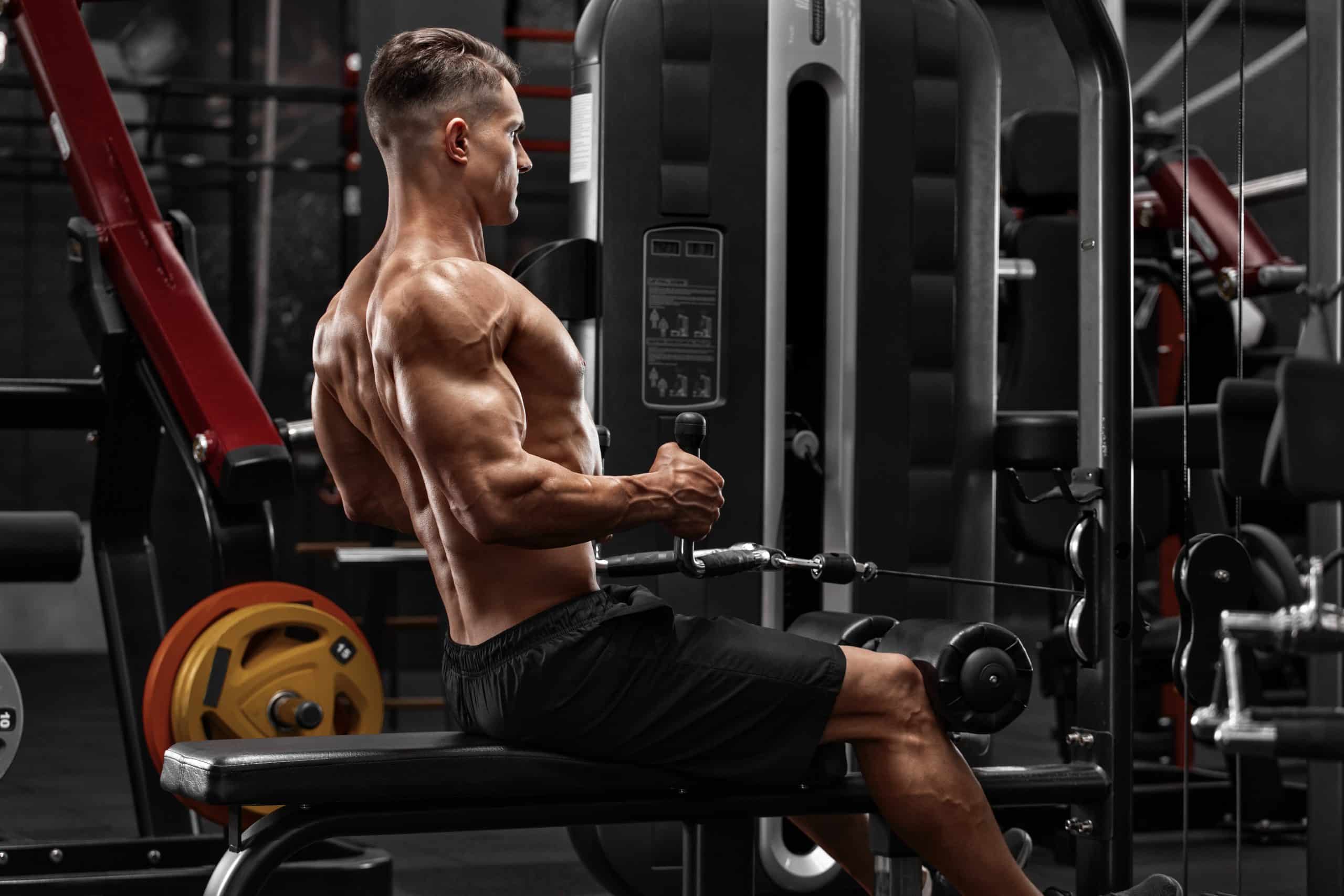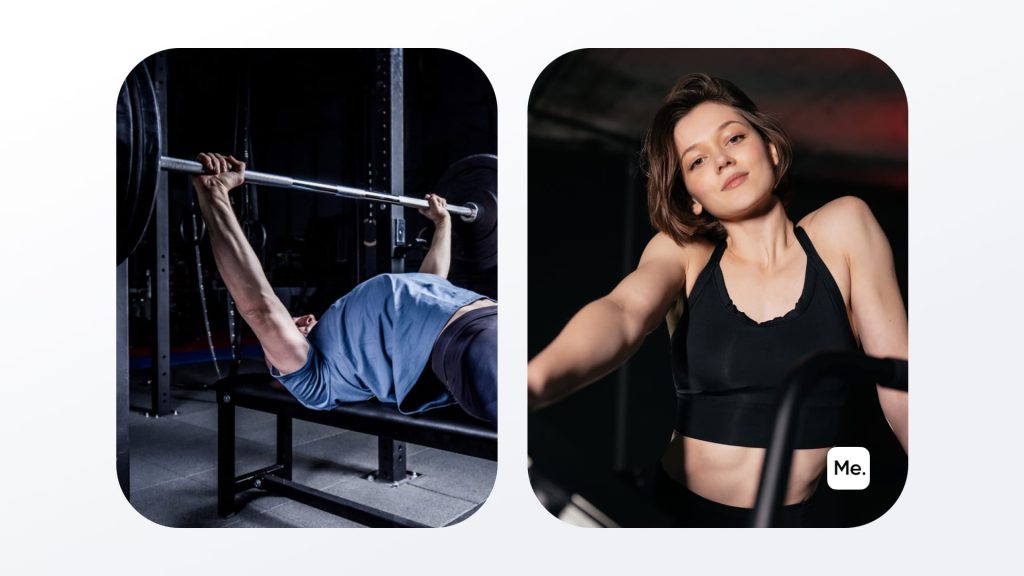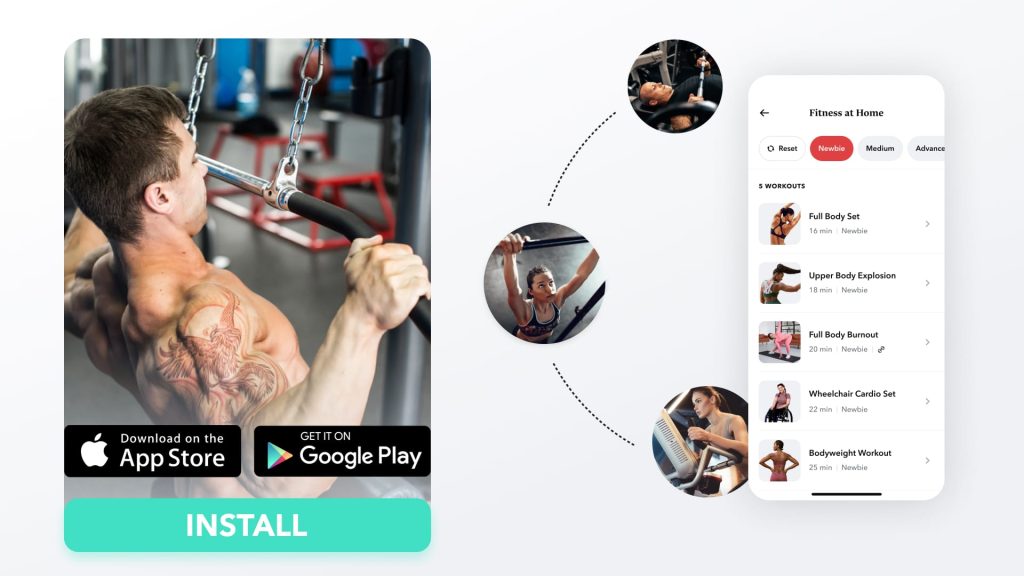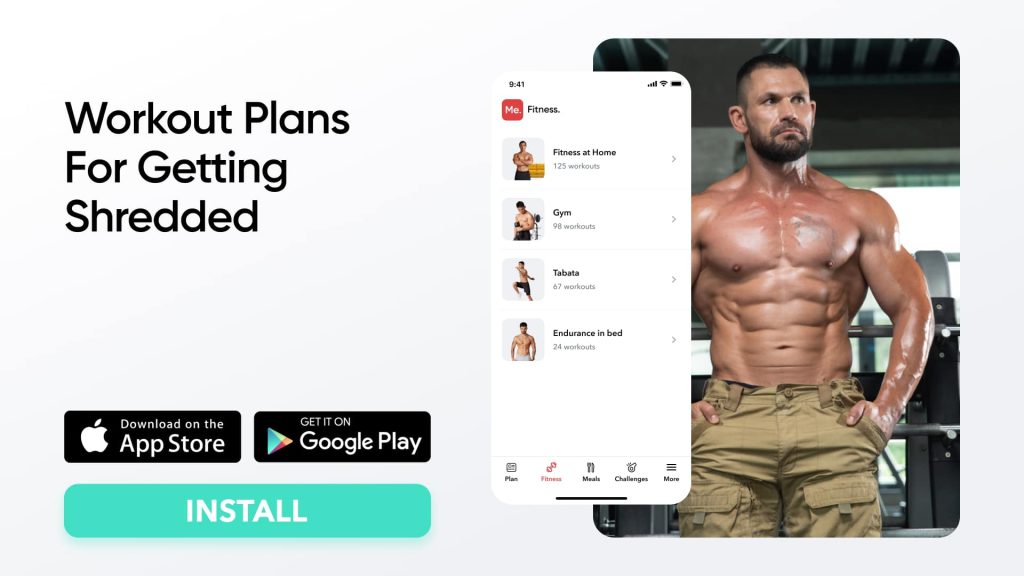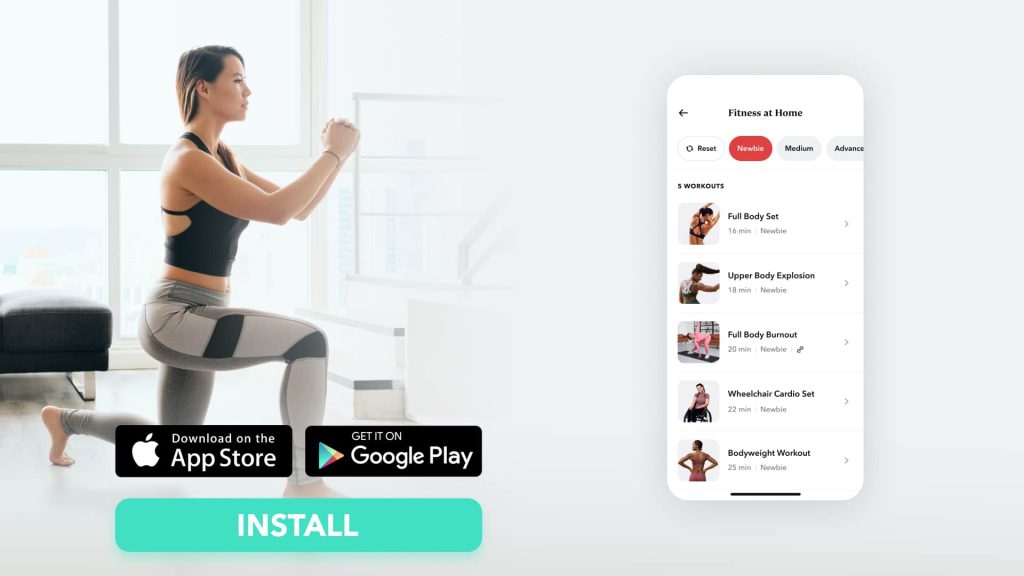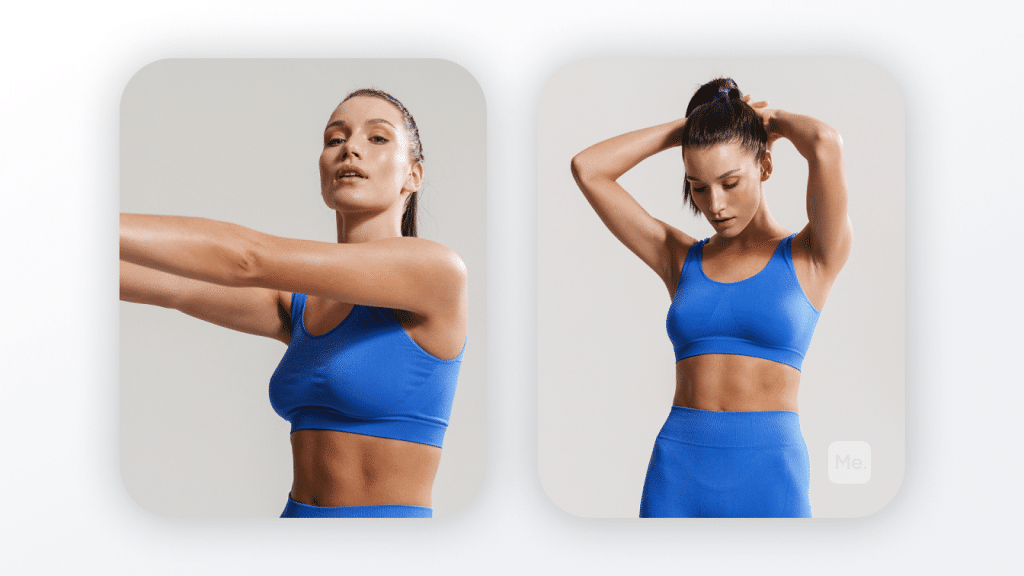A strong back does more than make you look good in a tank top. A powerful back is essential for posture, helps to protect your spine, and gives you the strength needed for just about any activity. Rows are among the best exercises for targeting your back, and there are a variety of different row variations that you can do to keep your workouts interesting. To make your back day at the gym more effective, we’ve compiled the best row variations that target your back muscles from a variety of angles. We’ll also take you through the proper form for each exercise so that you get the most out of your workout and avoid any injuries.
Get your personalized
meal plan!
Row Muscles Worked
Understanding the anatomy and functions of the muscles that make up your back will give you a better idea of how different row variations can help you achieve your fitness goals.
Latissimus Dorsi
The latissimus dorsi, commonly referred to as the “lats,” are the large, flat muscles that run from your lower back to your armpits (2). These muscles are responsible for bringing your arms down and back, as well as rotating your arms inward.
The lats are activated during rowing motions, which is why rows are an effective exercise for developing this muscle group.
Trapezius
The trapezius, or “traps,” are a muscle group that extends from the base of your neck to the middle of your back. These muscles are responsible for moving your shoulders and can assist with holding your head up (4).
In your day-to-day life, the traps are used whenever you shrug your shoulders. The trapezius is also activated during rowing motions, which is why rows are an effective exercise for developing this muscle group.
Rhomboids
The rhomboids are a muscle group that extends from the base of your neck to the middle of your back. They comprise two muscles, the rhomboid major and the rhomboid minor. These muscles are responsible for moving your scapula (shoulder blade) (3).
In your daily life the rhomboids are necessary for smooth movement of your arms and shoulders like when you’re reaching for something.
Erector Spinae
The erector spinae is a muscle group that extends along the length of your spine from your sacrum to your cervical vertebrae.
It consists of three muscles: the iliocostalis, longissimus, and spinalis (9). This muscle group is responsible for maintaining the natural curve of your spine and keeping you upright.
Day in and day out, the erector spinae is used whenever you stand up from a seated position or bend over. All movements that involve the extension of the spine will activate the erector spinae.
Teres Major
Certain variations of the row exercise will also target the teres major, which is a small muscle located in your upper back. This muscle assits the lats in bringing your arm down and back, as well as rotating your arm inward (10).
Rear Delts
Just like the teres major, certain variations of the row will also target the rear deltoids, or “rear delts.” The rear delts are the muscle group that makes up the back of your shoulder.
These muscles bring your arm forward and backward as well as rotating your arm outward (5).
Read More: Benefits Of Hill Running And How To Do It Correctly
Benefits Of Rows And Back Training In General
There are several benefits to be gained from regularly incorporating rows into your workout routine. In addition to strengthening the muscles that make up your back, rows can also help:
Improve Posture
One of the most common complaints when it comes to modern living is poor posture (8). This is primarily because we spend the majority of our days seated in front of a computer.
This hunched-over position can lead to several problems, including back pain, headaches, and neck pain (1). By strengthening your back muscles with rows (and other back exercises), you can improve your posture and alleviate some of these problems.
Reduce The Risk Of Injury
A strong back can help protect your spine and reduce the risk of injury (6). This is especially important if you participate in activities that put strain on your back, such as lifting heavy weights or playing contact sports. By regularly incorporating rows into your workout routine, you can help to keep your back strong and healthy.
Enhance Performance In Other Exercises
Strong back muscles can also enhance your performance in other exercises (7). For example, if you’re a runner, having strong back muscles can help you maintain good form and improve your breathing.
In addition, strong back muscles can help to stabilize your body during other exercises, such as squats and deadlifts. This can help you lift heavier weights and achieve greater results.
What Kind Of Rows Are There?
In its most basic form, the row is an exercise that involves pulling a weight towards your body while bent over and keeping your back straight. However, there are many different variations of this exercise that can target different muscle groups.
Some of the most common variations include:
Bent-Over Barbell Rows
This is the most basic variation of the row and one that can be performed with several different types of equipment. To perform this exercise:
- Stand with your feet hip-width apart and bend your knees slightly.
- Bend at the hips and lower your torso until it’s parallel to the ground.
- Keep your back straight and your core engaged throughout the exercise.
- From this position, row the weight up towards your chest, keeping your elbows close to your body.
- Pause for a moment at the top of the movement and then lower the weight back to the starting position.
Pendlay Rows
Named after Olympic weightlifter Glenn Pendlay, this variation of the row is similar to the bent-over barbell row. However, there is one key difference.
Each rep starts with the weight resting on the floor, unlike the bent-over row where the weight is already in your hands when you start the movement.
Rowing the weight from the floor forces you to lift the weight from a dead stop, which can help increase muscle activation. Because the bar starts on the floor for each rep, pendlay rows are easier on the lower back than the traditional variation.
To perform this exercise:
- Stand with your feet hip-width apart and place a barbell in front of you on the floor.
- Bend at the hips and lower your torso until it’s parallel to the ground.
- Grasp the barbell with an overhand grip and row the weight up towards your chest, keeping your elbows close to your body.
- Pause for a moment at the top of the movement and then lower the weight back to the floor, letting it rest momentarily before performing the next rep.
Betterme will keep you laser-focused on your weight loss journey! Nutrient-packed meal plans, fat-blasting workouts, galvanizing challenges and much more. Try using the app and see for yourself!
Seated Cable Rows
This variation of the row is performed using a cable machine. It’s a great exercise for beginners because it’s relatively easy to maintain good form. In addition, the seated position takes some of the strain off of your lower back.
To perform this exercise:
- Sit on a bench or chair in front of a cable machine and adjust the seat so that your legs are bent at a 90-degree angle.
- Grasp the handle with an overhand grip and row it back towards your body, keeping your elbows close to your sides.
- Pause for a moment at the top of the movement and then slowly return the handle to the starting position.
Inverted Rows
This variation of the row is performed using a Smith machine or TRX straps. It’s a challenging bodyweight move that is surprisingly easy to scale. You can make them harder by elevating your feet on a bench, or easier by bending your knees.
To perform this exercise:
- Adjust the Smith machine bar to about waist height and lie underneath it.
- Grasp the bar with an overhand grip, keeping your hands shoulder-width apart.
- Engage your core and pull yourself up until your chest touches the bar.
- Pause for a moment at the top of the movement and then lower yourself back to the starting position.
One-Arm Dumbbell Rows
This variation of the row allows you to focus on one side of your body at a time, which can help correct any muscular imbalances. It’s also a great exercise for working your stabilizer muscles.
To perform this exercise:
- Place a dumbbell on the floor and stand with your feet hip-width apart.
- Hinge at the hips and lower your torso until it’s almost parallel to the ground.
- Pick up the dumbbell with your right hand and row it up towards your chest, keeping your elbow close to your body.
- Pause for a moment at the top of the movement and then lower the weight back to the starting position.
- Repeat with your left arm.
Prone Incline Dumbbell Bench Row
The prone incline dumbbell bench row requires you to lie facedown on an incline bench while rowing. This position offers several benefits. For one, it maximizes the isolation of the back muscles.
In addition, it takes the lower back and hips out of the movement, which can help prevent injury. This move can’t be executed on a standard flat bench as there won’t be enough space allowing for full extension of the arms.
To perform this exercise:
- Adjust an incline bench to a 45-degree angle and lie facing down on it. Your feet should be planted firmly on the floor.
- Pick up a dumbbell in each hand and lead with your elbows to row the weights up towards your chest.
- Pause for a moment at the top of the movement and then lower the weights back to the starting position.
Renegade Rows
Renegade rows are a great full-body move that challenges your stability and forces your muscles to work together. Because they require you to engage your core, they can also help improve your posture.
They are executed in a plank position that can be modified to make the move easier or harder.
To perform this exercise:
- Assume a push-up position with your feet hip-width apart and place your hands on dumbbells that are shoulder-width apart.
- Keeping your core engaged, row one weight up towards your chest while keeping your body in a straight line.
- Lower the weight back to the starting position and repeat with the other arm.
- Continue alternating sides until all reps are complete.
Head-Supported Barbell Bentover Row
When lifting heavy weights in the traditional, bent-over row position, you might strain your lower back.
This move offers a solution by allowing you to support your head on a bench while performing the exercise. This takes the lower back out of the movement and allows you to focus on working your upper back muscles.
To perform this exercise:
- Place a barbell on the floor in front of a flat bench.
- Hinge at the hips and lower your torso until it’s parallel to the floor.
- Place your head on the bench and grab the barbell with an overhand grip, keeping your hands shoulder-width apart.
- Row the weight up towards your chest, pause for a moment at the top of the movement, and then lower it back to the starting position.
Read More: Standing Barbell Calf Raise: Benefits, Variations, And Mistakes To Avoid
Yates Row
The Yates row, named after Olympian Dorian Yates, is a variation of the barbell row that’s performed with a narrower, underhand grip. This allows you to keep your elbows closer to your body, which maximizes the recruitment of the back muscles.
It specifically targets the biceps, traps, and upper back. The underhand grip is usually more comfortable than an overhand grip, making this variation a good choice for beginners.
To perform this exercise:
- Place a barbell on the floor and stand with your feet hip-width apart.
- Hinge at the hips and lower your torso until it’s almost parallel to the ground.
- Grab the barbell with an underhand grip, keeping your hands shoulder-width apart.
- Row the weight up towards your chest, pause for a moment at the top of the movement, and then lower it back to the starting position.
T-Bar Row
The T-bar row is a great exercise for building strength and size in the back muscles. It can be performed with a barbell or T-bar, but the latter is often recommended as it’s easier to grip and offers more stability.
This move also challenges your core stability as you have to resist the temptation to twist your body as you row the weight up.
To perform this exercise:
- Load a barbell or T-bar onto a landmine or plate-loaded machine and position it so that it’s at about hip height.
- Straddle the bar and grab it with an overhand grip, keeping your hands shoulder-width apart.
- Hinge at the hips and lower your torso until it’s almost parallel to the ground.
- Keeping your core engaged, row the weight up towards your chest.
- Pause for a moment at the top of the movement and then lower it back to the starting position.
BetterMe app will kick you out of the mental funk, shake off your extra weight, rid you off your energy-zapping habits, and help you sculpt the body of your dreams. Intrigued? Hurry up and change your life for the better!
Helms Row
The Helms row is a great exercise for targeting the hard-to-reach lower trapezius muscles. This muscle group helps stabilize the shoulder blades and is often neglected in training programs.
As a result, these muscles can become weak and contribute to poor posture. This exercise is a chest-supported version of the row that allows you to focus on working the lower traps.
To perform this exercise:
- Adjust an incline bench to a 45-degree angle, and drape a towel over the top edge of the bench to protect your chest while you row.
- Stand next to the bench and place your chest on the towel.
- Grab a dumbbell in each hand and let them hang at arm’s length by your sides.
- Row the dumbbells up towards your chest, pause for a moment at the top of the movement, and then lower them back to the starting position.
Barbell Seal Row
This variation is performed on a seal brown bench. You can also improvise with plyo boxes or aerobics steps to achieve the same posture.
While lying prone, you can’t depend on momentum to help you move the weight. This exercise forces your back muscles to work hard to move the load. This is a great exercise for targeting the middle and lower trapezius muscles.
To perform this exercise:
- Place a barbell on the floor under a seal brown bench or similar platform.
- Lie prone on the seal row bench and grab the barbell with an overhand grip, keeping your hands shoulder-width apart.
- Row the weight up towards your chest, pause for a moment at the top of the movement, and then lower it back to the starting position.
The Bottom Line
Barbell rows are a great exercise for building strength and size in the back muscles. They can be performed with a variety of grip widths and hand positions to target different muscle groups.
DISCLAIMER:
This article is intended for general informational purposes only and does not serve to address individual circumstances. It is not a substitute for professional advice or help and should not be relied on for making any kind of decision-making. Any action taken as a direct or indirect result of the information in this article is entirely at your own risk and is your sole responsibility.
BetterMe, its content staff, and its medical advisors accept no responsibility for inaccuracies, errors, misstatements, inconsistencies, or omissions and specifically disclaim any liability, loss or risk, personal, professional or otherwise, which may be incurred as a consequence, directly or indirectly, of the use and/or application of any content.
You should always seek the advice of your physician or other qualified health provider with any questions you may have regarding a medical condition or your specific situation. Never disregard professional medical advice or delay seeking it because of BetterMe content. If you suspect or think you may have a medical emergency, call your doctor.
SOURCES:
- Adverse Effects of Prolonged Sitting Behavior on the General Health of Office Workers (2017, ncbi.nlm.nih.gov)
- Anatomy, Back, Latissimus Dorsi (2022, ncbi.nlm.nih.gov)
- Anatomy, Back, Rhomboid Muscles (2022, ncbi.nlm.nih.gov)
- Anatomy, Back, Trapezius (2021, ncbi.nlm.nih.gov)
- Anatomy, Shoulder and Upper Limb, Deltoid Muscle (2022, ncbi.nlm.nih.gov)
- Back Injury Prevention (2017, researchgate.net)
- Back Problems: Pros and Cons of Core Strengthening Exercises as a Part of Athlete Training (2021, mdpi.com)
- Posture (n.d., physio-pedia.com)
- The Intrinsic Back Muscles – Attachments – Actions (n.d., teachmeanatomy.info)
- The supporting role of the teres major muscle, an additional component in glenohumeral stability? An anatomical and radiological study (2020, sciencedirect.com)
